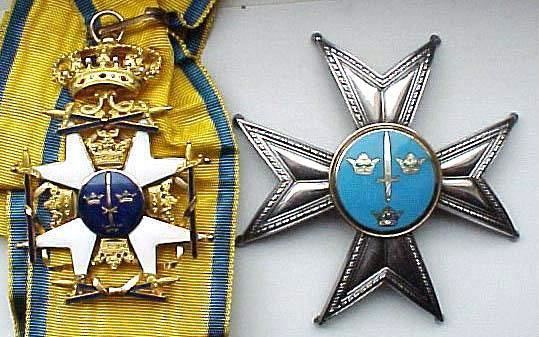Motto Pro Patria Eligibility Military personnel | Day 28 April | |
 | ||
Type Five grade order of merit Awarded for Valour during war and service to the Armed Forces during peacetime. Status Cureently Open only for the monarch | ||
The Order of the Sword (officially: Royal Order of the Sword; Swedish: Kungliga Svärdsorden) is a Swedish order of chivalry created by King Frederick I of Sweden on February 23, 1748, together with the Order of the Seraphim and the Order of the Polar Star.
Contents
Awarded to officers, and originally intended as an award for bravery and particularly long or useful service, it eventually became a more or less obligatory award for military officers after a certain number of years in service. There were originally three grades, Knight, Commander and Commander Grand Cross, but these were later multiplied by division into classes.
The motto of the order is in Latin: Pro Patria (which means "For Fatherland").
History
The order was created by King Frederick I in 1748, along with two other orders, the Order of the Seraphim and the Order of the Polar Star. In 1788, King Gustav III created two new grades of the order, which could only be bestowed in war time:
These grades proper were only given to commissioned officers, but an affiliated decoration, the Svärdstecken ("Badge of the Sword"), introduced in 1850, was given to non-commissioned officers; one thus decorated would call himself a svärdsman ("Sword man"). A Medal of the Sword was also introduced for enlisted men. Both the non-commissioned officers and the enlisted men had to have served for at least sixteen years to qualify respective for the Badge and Medal.
In 1952 a special medal of distinction was added to the order. These could only be bestowed in wartime. They are the War Cross of the Order of the Sword in Gold, in Silver and in Bronze. They are worn on the same ribbon as the order and the medal consist of the cross saltire of the Order struck in gold, silver or bronze, with an upraised sword behind central medallion bearing the Swedish three crowns and in the spaces between the upper and lower arms of the cross. At the top of the points of the upper arms of the cross and of the sword is a small royal crown.
The order is no longer awarded since 1975, but technically it still exists. King Carl XVI Gustaf of Sweden frequently wears his Commander Grand Cross necklet and badge.
Formerly the reception of new Commanders Grand Cross took place without religious ceremonies in the royal apartments, but in the presence of the other Commanders Grand Cross of the Order, of the Knights of the Seraphim, and the Commanders Grand Cross of all the other orders. By the oath the Commander elect bound himself “to defend with life and property the Evangelical-Lutheran religion, to serve faithfully the King and the country, and to combat courageously against the foes of the country.” When a foreigner was elected a Commander of the Grand Cross, the insignia were sent to him abroad, while he, in his turn, transmitted to the archives of the Order a statement of the services rendered by him.
Grades
The Order of the Sword in peacetime had five classes:
The order also encompasses two medals;
Both medals are worn on a ribbon on the left chest.
Insignia and habit
The badge of the Order is a white enamelled Maltese Cross in saltire (i.e. "X" shaped), in silver for Knight class and in gold for the Knight 1st Class and above; gold open crowns appeared between the arms of the cross. The obverse central medallion bears an upright gold sword between three gold crowns on a blue enamelled background; the reverse central medallion has an upright gold sword intersecting a gold laurel wreath, and the Latin legend "Pro Patria" (For Fatherland) on a blue enamelled background. A pair of crossed gold swords in blue enamelled scabbards with downward turned blades lie across the opening between the upper arms of the cross at the top of the badge. In addition the badges of the two highest classes also have an upright similar gold and blue sword across the openings at the sides of the cross and an identical pair of crossed gold and blue swords with downwards turned blades across the opening between the lower arms of the cross at the bottom of the badge, the pairs of crossed swords are each tied together and the side swords are bound to the cross by a single gold ribbon which crosses the arms of the cross from behind. The badge hanged from a gold and enamelled royal crown.
Formerly the Order also had a distinctive blue and yellow habit worn on formal occasions such as at chapters of the Order. The habit included yellow trousers, a yellow knee length coat with blue shoulder tabs and a yellow girdle, each bordered in blue, blue mantle lined with blue satin and a blue shoulder sash with a gold fringe. The star of the Order was embroidered over the left breast of both the coat and the mantle. A black top hat with gold hat band and a plume of white ostrich and black egret feathers and a pair of black boots with gilded spurs completed the habit. The collar of the Order was worn over the shoulders of the coat.
